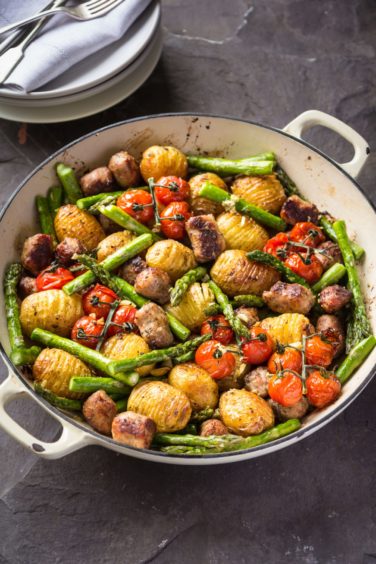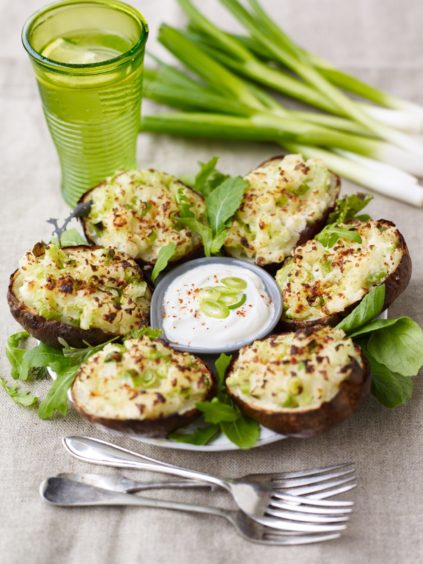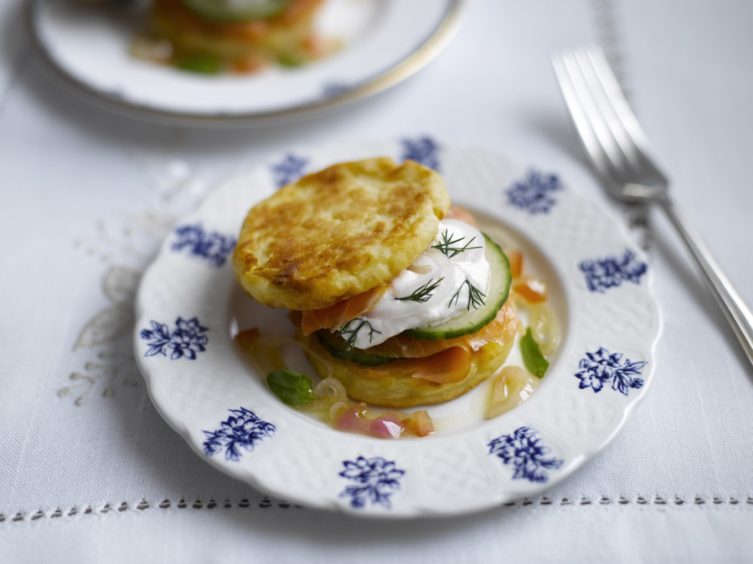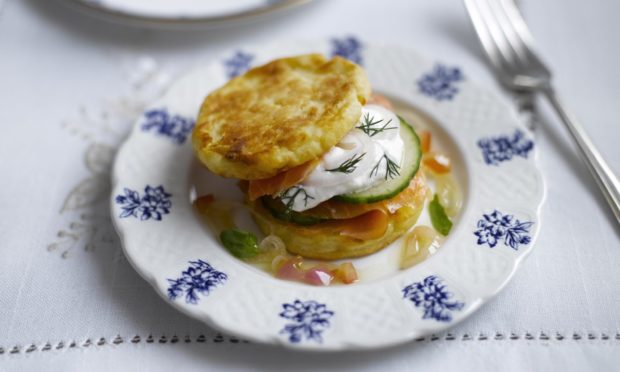If you like your potatoes, you’ll love these three recipe ideas to use them in a main meal.
The versatility of potatoes is no secret, they are the perfect addition to any meal and are one of the best sources of potassium you can include in your diet.
Other benefits from eating potatoes include fibre, vitamin C, and complex carbohydrates, while they are naturally fat free, cholesterol free and contain no sodium.
For more three ways’ inspiration, take a look at the previous recipes we’ve featured here.
One pan sausage-meatball roast with asparagus and new potatoes
(Serves 4)

Ingredients
- 1kg small new potatoes
- 4 tbsp olive oil
- 1 tsp dried oregano
- 8 thick pork sausages
- 400g cherry vine tomatoes
- 2 cloves garlic, chopped
- 2 bunches asparagus, trimmed and cut in half
- Salt and freshly ground black pepper
Method
- Preheat the oven to 180C fan. Using a sharp knife, make a series of thin slices (about 2mm apart) all along the new potatoes, cutting down about three quarters of the way through so the potatoes stay intact at the base.
- Add to a large roasting tin and drizzle over the olive oil, sprinkle on the oregano and season with salt and pepper. Toss about to evenly coat. Roast for 10 minutes.
- Cut each sausage into four, peeling away and discarding the skins as you go.
- Remove the potatoes from the oven, scatter around the sausage pieces and slide back into the oven for another 15 minutes.
- Remove the roasting tin from the oven once more, scatter over the tomatoes and the garlic and toss to coat, turning the potatoes so they are all cut side up. Slide back into the oven and roast for another 10 minutes.
- Finally, add the asparagus to the tin, tossing to coat and roast for five more minutes. Remove from the oven and serve straight away.
Recipe from enjoyasparagus.com
Spring Onion and Celery Loaded Potato Skins
(Serves 4 as a starter or 2 as a main course )

Ingredients
- 2 large baking potatoes
- 2 tsp olive oil plus extra for dressing the leaves
- Salt and freshly ground black pepper
- 2 tbsp sour cream
- 25g cheddar cheese
- 4 spring onions, finely chopped
- 2 sticks of celery.
- Finely chopped pinch of smoked paprika (optional)
- Bag of Fresh & Naked spicy mixed leaves
Method
- Heat the oven to 200C/180C fan. Prick the potatoes a few times with a fork.
- Put the oil in a medium bowl with a good pinch of salt and pepper and, one at a time roll the potatoes in it so they’re completely covered.
- Bake in the oven for an hour until they’re crispy on the outside and soft in the middle. Leave to cool slightly. Once they’re cool enough to handle, cut in half and scoop out the centre.
- Use a fork to mash the potato in a bowl with the sour cream and cheddar then stir in the spring onions and celery and season.
- Load the mash mixture back into the skins, sprinkle with a pinch of smoked paprika (if using) and grill for a few minutes until the tops start to brown.
- Toss the mixed leaves in a little olive oil and season, put on a platter or divide between plates and top with the loaded skins.
Recipe from lovecelery.co.uk
Potato Pikelets, Smoked Salmon and Creme Fraiche with Shallot Sauce
(Serves 4)

Ingredients
For the sauce:
- 100ml extra virgin olive oil
- 50g shallots, finely diced or in rings
- 1 lemon, zest and juice
- 1 clove of garlic, bruised
- 1 sprig of thyme
- 1 bay leaf
- 25ml sherry wine vinegar
- 2 really ripe plum tomatoes, skinned, deseeded and cut into 1cm dice
- Sea salt and mill pepper to taste
- Basil leaves from 2-3 stems, finely chopped
For the pikelets:
- 500g floury potatoes
- 60g unsalted butter, melted
- 1 egg yolk
- 250g thinly sliced smoked salmon
- 50ml horseradish
- 50ml crème fraiche
- 10 chives, most finely chopped but keep a few long batons for decoration
- 2 shallots
- 2 sprigs of dill
- 1 cucumber, sliced
- Black mill pepper to taste
Method
- Firstly make the base for the sauce. Place all of the ingredients apart from the vinegar, tomatoes and basil into a small pan and put onto a gentle heat.
- Warm the sauce until it is hot but not boiling and cook for about 20 minutes. The shallots should be cooked and soft but not coloured.
- The sauce can now be poured into a clear jar, covered and stored in the fridge when cool. I think this sauce is better made a day or two before you intend to use it, as it allows the flavours to infuse. With correct storage it will keep for a couple of weeks.
- Peel, quarter and cook the potatoes on a steady simmer until just cooked. Take care not to overcook the potatoes and let them become watery.
- Drain the cooked potatoes then return them to the pan and set over a low heat to evaporate off excess liquid. Mash the potatoes through a moulin or potato ricer into a bowl and work in the melted butter and egg yolk.
- Season the mix and divide into eight or 10 balls. Flatten the balls in a little flour to form pikelets and set on to a clean well-oiled baking tray. Bake the pikelets in a 180C oven for 20 minutes.
- Carefully turn them over and cook for a further 20 minutes until light golden brown. Allow the pikelets to cool then store them in an airtight box.
- To finish the sauce, warm it through once more and remove the garlic, thyme and bay. Stir in the vinegar and add the diced tomato and basil.
- To serve set one of the pikelets in the centre of the plate and lay a slice of salmon on top.
- Place three slices of cucumber on the salmon with the edges showing. Mix some of the chives into the crème fraiche and then combine the crème fraiche and horseradish.
- Dress with the chive crème fraiche mixture, add the shallot rings and place a second slice of salmon on top.
- Season with black pepper and finish with a second pikelet laid at an angle and some long chive batons. Spoon around some of the shallot sauce and serve.
Recipe from ukshallot.com
